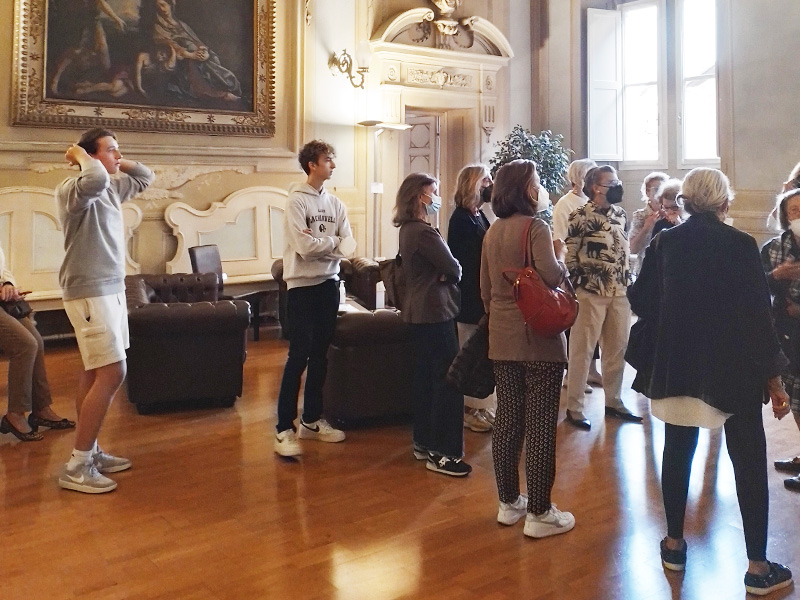
Alberti created a single architectural complex from an enclave of eight smaller buildings. It is always a pleasure to wander its corridors while admiring the frescos.
On October 18, 2022 the lucky visitors of Palazzo Rucellai were the members of Istituto Italiano dei Castelli (Tuscan division), together with Amici dei Musei di Palazzo Davanzati and Casa Martelli.
Accompanying them was the writer and journalist Daniela Cavini, who has devoted the central chapters of her latest book, Storia di un’altra Firenze (Neri Pozza, 2021), to the Rucellai family and their home.
An exceptional guide, alongside Cavini, was Prof. Stefano Baldassarri, director of ISI Florence, whose students now occupy the rooms in which Giovanni, Bernardo, and their descendants once lived.
The Rucellai family lived in the neighborhood of San Pancrazio (area around Piazza Santa Maria Novella) and had made their fortune thanks to a purple fabric dye (oricello rosso). The Rucellai discovered the dye’s production method in the 12th century and have kept it as a secret ever since. When the Rucellai sided against Cosimo de’ Medici, they were banished from the city’s political life for 30 years. The family managed to stay afloat thanks to the substantial proceeds of textile dying which, alongside the patronage of arts and real estate commissions, kept the Rucellai from sinking into oblivion.
With the enthusiasm that also characterizes her writing, the tour by Daniela Cavini brought to life the anxiety of the political ostracism lived by Giovanni, his desire to reestablish himself, and his commitment to mend the relationship with the Medici – the new signori of Florence – which culminated with the marriage between Giovanni’s son, Bernardo, and Nannina de’ Medici, sister to Lorenzo Il Magnifico.
Prof. Baldassarri showed the visitors around each room, explaining specific features of the palace such as the late Baroque remodeling, the mirrors, the busts depicting Roman emperors that replaced medieval tapestries, and the spiral staircase designed by Alberti himself as a way for servants to move discretely between floors.
The visitors then walked across the Ballroom, the Hall of Stuccoes, and the Hall of Muses, where their eyes were set on the mesmerizing ceiling. The ceiling’s fresco depicts four muses waiting to ascend to the Temple of Fame, each holding a drawing of the best that the Rucellai family left to the world through its patronage. There is the famous Madonna painted by Duccio da Boninsegna and a collection of verses and tragedies written by Giovanni. The central piece of the “treasure” is a scroll of architectural works held by two putti and rolled out for guests to see: well recognizable on the scroll are the façade of Santa Maria Novella, the small temple of San Sepolcro, and the Loggia that faces the Rucellai residence itself.
The visit came to an end in front of the Loggia and the famous façade, an incredible makeover operation necessary to give the illusion of a real palace, and not a mosaic of pieces sewn together. It is here that the marriage of the century is celebrated, the linking of the Rucellai with the Medici, in this Loggia built “per honore della nostra famiglia, per adoperarla per le letitie e per le tristitie” (in honor of our family, to be used in rejoicing and sorrow).
